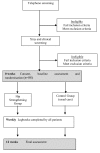The effects of hip muscle strengthening on knee load, pain, and function in people with knee osteoarthritis: a protocol for a randomised, single-blind controlled trial
- PMID: 18067658
- PMCID: PMC2235855
- DOI: 10.1186/1471-2474-8-121
The effects of hip muscle strengthening on knee load, pain, and function in people with knee osteoarthritis: a protocol for a randomised, single-blind controlled trial
Abstract
Background: Lower limb strengthening exercises are an important component of the treatment for knee osteoarthritis (OA). Strengthening the hip abductor and adductor muscles may influence joint loading and/or OA-related symptoms, but no study has evaluated these hypotheses directly. The aim of this randomised, single-blind controlled trial is to determine whether hip abductor and adductor muscle strengthening can reduce knee load and improve pain and physical function in people with medial compartment knee OA.
Methods/design: 88 participants with painful, radiographically confirmed medial compartment knee OA and varus alignment will be recruited from the community and randomly allocated to a hip strengthening or control group using concealed allocation stratified by disease severity. The hip strengthening group will perform 6 exercises to strengthen the hip abductor and adductor muscles at home 5 times per week for 12 weeks. They will consult with a physiotherapist on 7 occasions to be taught the exercises and progress exercise resistance. The control group will be requested to continue with their usual care. Blinded follow up assessment will be conducted at 12 weeks after randomisation. The primary outcome measure is the change in the peak external knee adduction moment measured during walking. Questionnaires will assess changes in pain and physical function as well as overall perceived rating of change. An intention-to-treat analysis will be performed using linear regression modelling and adjusting for baseline outcome values and other demographic characteristics.
Discussion: Results from this trial will contribute to the evidence regarding the effect of hip strengthening on knee loads and symptoms in people with medial compartment knee OA. If shown to reduce the knee adduction moment, hip strengthening has the potential to slow disease progression.
Trial registration: Australia New Zealand Clinical Trials Registry ACTR12607000001493.
References
-
- Australia A. Painful Realities: The economic impact of arthritis in Australia in 2007. 2007.
-
- Badley E, Wang P. Arthritis and the aging population: projections of arthritis prevalence in Canada 1991 to 2031. Journal of Rheumatology. 1998;25:138–144. - PubMed


